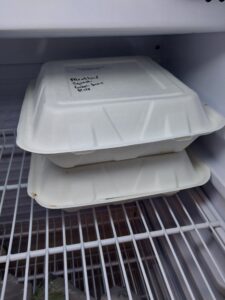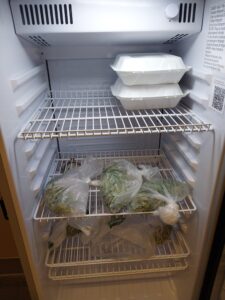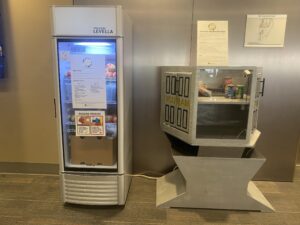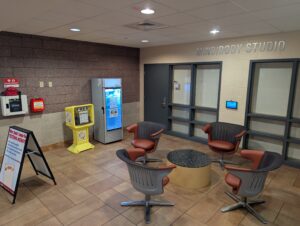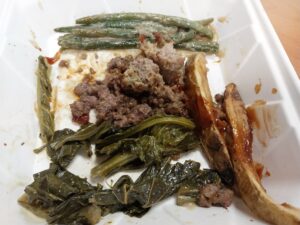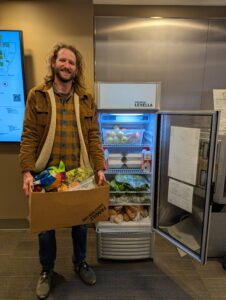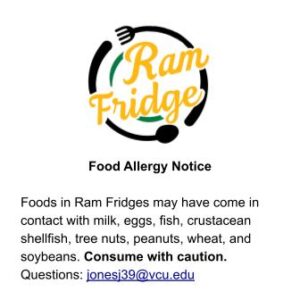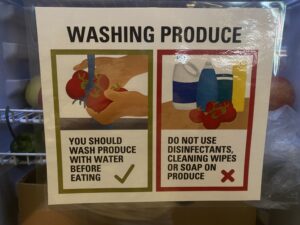Progress report for FLW24-004
Project Information
This project seeks funding to transform Virginia Commonwealth University’s (VCU) campus food system by reducing unnecessary food waste with three objectives. VCU is a large urban university composed of twenty one higher education units including a world renowned liberal arts campus, a medical campus and hospital, while participating in Division I NCAA athletics. VCU is also embedded into the fabric of an urban environment that encompasses a diverse range of socioeconomic backgrounds and cultural interactions. Currently, VCU has little capacity to track or reduce food waste beyond internal efforts by our food service partner, Aramark. An alliance of senior administrators, VCU Sustainability, and faculty members aim to change this reality in line with modern sustainable food management practice (US EPA). Initial efforts will focus on VCU’s central all-you-can-eat cafeteria before eventually expanding our innovations to the hospital system cafeterias and to VCU Athletics. Efforts will proceed in a staggered and controlled rollout taking place over the course of the funded three years, but with the intention to to expand to other parts of VCU beyond the funded timeline.
The first objective is to develop and implement an innovative system to track both edible and inedible institutional food service pre-consumer and post-consumer food waste (Natural Resources Defense Council, 2017) at VCU’s central all-you-can-eat cafeteria. Such a system can better inform purchasing and food preparation decisions by VCU Dining (i.e., source reduction), characterize consumer habits (towards behavioral change) and support the development of educational initiatives towards both cafeteria and customers. Further, characterization of post consumer waste streams will inform overall human and environmental health impacts.
The second objective is to divert unprepared and unserved pre-consumer food portions from the cafeteria to a network of decentralized, anonymous SMART community refrigerators on and off-campus. These include the VCU campus food pantry network (“Ram Pantry”). This objective will enhance the existing sensor system created for the network of similar on-campus, dry goods food pantries (“Little Ram Pantries”). The next-generation SMART systems include inward-facing cameras linked to a website, allowing for monitoring of inventory and usage. This sensor data will allow the research team to optimize food diversion to Ram Pantry and off-campus partners. These off-campus partners include RVACommunity Fridges (an emerging decentralized network of mutual aid fridges and dry-goods pantries scattered across the greater Richmond region) and five VCU affiliated older adult living facilities.
The third objective reduces food waste through evaluation, education, training, and outreach. Tasks include developing an interactive dashboard, a virtual website for real-time waste statistics, conducting portion adjustment trials, and creating best practice documents based on evaluations. This objective employs focus groups with food waste recipients, performs geospatial analysis of pantry sensor data, will host a workshop for Virginia higher education institutions and provide for educational resources that can be adopted broadly. By fostering sustainability and engaging the on and off campus community, VCU can become a national leader in food waste reduction!
Objective 1: Implementing Waste Tracking System
Task 1.1: Tracking Food Preparation and Serving Waste
- Install high-precision digital scales for waste measurement and data collection in Shafer Dining Hall.
Task 1.2: Development and Evaluation of Automated Plate Waste
Tracking System
- Subtask 1.2.1: Design and Development Phase
- Develop Plate Waste Tracking (PWT) units with advanced technologies for waste measurement.
- Tag dining plates with Radio Frequency Identification (RFID)/Near-field communication (NFC) for tracking.
- Implement high-resolution cameras and machine learning models for portion size estimation.
- Assemble and test prototype devices.
- Subtask 1.2.2: Deployment and Evaluation Phase
- Pilot implementation of PWT units at select stations.
- Train graduate students for manual measurement and recording.
- Monitor data integrity and system performance.
Task 1.3: Large-Scale Data Collection and Analysis
- Gather comprehensive data across Shafer service areas.
- Correlate waste data with consumer metrics and environmental conditions.
- Generate detailed reports on food waste by type and purchase origins.
Objective 2: Establishing a Food Diversion System
Task 2.1: Food Waste Diversion with Goodr and Ram Fridges
- Divert unprepared or unserved pre-consumer food portions from Shafer to a decentralized network of campus sensor-enabled food pantry refrigerators (Ram Fridges). In some cases, Objective 1 will assist both in diverting foods to the refrigerators but also in right-sizing portions to reduce the potential for food waste in the long-term.
Task 2.2: Divert Food to RVA Community Fridges
- Expand diversion efforts from Task 2.1 to support the off campus RVACommunity Fridge network.
- Provide a refrigerated trailer hitch and electrical upgrade for RVACommunity Fridge.
- Stipend for RVACommunity Fridge’s unofficial manager and honorariums for volunteers.
Task 2.3: Divert Food to Older Adult Living Facilities
- Expand diversion efforts from Task 2.1 to support VCU affiliated older adult living facilities.
- Coordinate with Gerontology faculty at VCU for minor assistance.
Task 2.4: Sensor Improvements
- Improve stability and add inward-facing cameras to the sensor system for real-time inventory and usage analysis.
Objective 3: Reducing Food Waste through Evaluation, Education, Training, and Outreach
Task 3.1: Dashboard Development and Implementation
- Develop and install an interactive dashboard for real-time waste statistics.
- Create a virtual dashboard and website featuring waste data, success stories, and educational resources.
Task 3.2: Portion Adjustment Trial
- Experiment with adjusting meal portion sizes based on historical data and immediate feedback.
- Collect and analyze data on waste quantities.
Task 3.3: Evaluation of Behavior Changes Interventions
- Evaluate results from dashboard and portion adjustment trials.
- Create best practice documents for VCU Dining and other institutions.
Task 3.4: Focus Groups of Diverted Food Waste Recipients
- Conduct focus groups to assess the effectiveness and impact of food diversion programs.
Task 3.5: Geospatial Analysis of Food Pantry Sensor Data
- Perform geospatial analysis of pantry sensor data to optimize placement and operation.
Task 3.6: Campus Food Waste Workshop for Virginia Higher Education Institutions
- Organize a workshop for staff and faculty from other Virginia institutions to share lessons learned.
Task 3.7: Presentation at Practitioner and Scholarly Conferences and Open Access Research Publication
- Present findings at conferences and publish research in open access journals.
Task 3.8: Development of Waste Reduction Educational Materials and Communication Strategies
- Create and implement training modules for VCU Dining staff to promote waste reduction behaviors among customers
- Work with VCU faculty to integrate food waste reduction and sustainability topics into existing course curricula
Task 3.9: Formation of Community Advisory Group
- Establish a community advisory group to coordinate off-campus food diversion.
Cooperators
Research
We have begun diversion efforts out of Shafer Dining Hall, VCU's all you can eat cafeteria. Diversion began slowly around Thanksgiving 2025. Aramark, the food service contractor for VCU, is responding to our efforts, but somewhat slower than the research team hoped. Currently, diversion efforts have focused exclusively on the "True Balance" station within Shafer. True Balance is the allergen friendly station. Consequentially, most of our diversion efforts have provided more or less complete meals from this station (often a protein, veggie, and starch). The research team initially envisioned more dish/batch specific diversion such an entire tray of macaroni and cheese cut into individual portions.
Thus far, all food diverted from Shafer is placed into the Ram Fridge located in the main library (located directly across a quad space from Shafer Dining Hall). In February, we launched our second Ram Fridge in the main student gym. As of this writing, we are working with Aramark to scale up our food diversion, and delivery logistics, to divert more food to now both Ram Fridges.
An example of food diverted from the True Balance Station are included as pictures. These pictures predate the use of our labeling.
- School/institution
- Donate or Upcycle
Year 1 of Objective 2 focuses on diverting food from Shafer Dining Hall, VCU's all-you-can-eat dining hall to our Ram Fridge program, currently two decentralized, anonymous food pantry refrigerators. The two Ram Fridges are located at highly visible locations at our main library and campus gym. Students can take food from these Ram Fridges without restrictions, as along as the respective buildings are open.
Ram Fridge in Library
Ram Fridge in Gym
As of 3/27/25, we have diverted 193 pounds of prepared food from Shafer Dining Hall to one of our Ram Fridges. Food is diverted in meal-based serving sizes of roughly 1 pound each, so effective we have diverted 193 meals. See below for diversion ratios.
Additionally, our team developed food safety protocols for the Ram Fridges to ensure the safety of any products placed in the fridges. As part of our agreement with VCU Risk Management, student workers conduct an inspection of each operational Ram Fridge three days a week (Monday, Wednesday, Friday) when the fridges are active. We intend to unplug the fridges during major school breaks (Winter + Summer). Inspections are an observational data collection process where the student reports information using their own senses and a thermometer inside the fridge to a standardized Google Form using their phone. If the student observed any damaged, spoiled, dramatically expired, or food that violates the Ram Fridges donation guidelines, they place that food in the garbage (and take a picture of it). Safety inspections began in November of 2024 when we launched the first Ram Fridge.
Through our tri-weekly observations, student observed the following:
- No major incidents of vandalism or damage observed
- Fridges were observed functioning and plugged in 100% of the time
- After market thermometers allowed the students to slightly adjust temperature controls to find ideal conditions
- Of the 30 instances where students threw away food from the fridges, only one instance was due to food diverted through this grant. All other instances were of rotting/damaged produced add to the fridge through on-campus food production efforts.
- The one instance were food diverted through this grant was trashed was due to the perception that meat loaf may have been under cooked (image listed below). In that case, the team contacted Aramark and reported this. Aramark investigated this and determined it to be red glazed used in the cooking process. While undesirable to the specific outcome, this process highlights the power of the inspection process to better protect against diverted food that is under cooked or spoiled.
Finally, the Ram Fridges also allowed team members to divert other foods that required refrigeration for students. One manifestation of that is the PI Jones) efforts to partner with a food waste diversion initiative in his neighborhood that partners with a Wegman's grocery store in the Richmond region. Each week that group obtains past use by label food waste from the Wegmans and then distributes it in the community garden. The PI diverts a portion of the left over food after the community has taken what they need and transports it to the Ram Fridges. We do not track poundage for this diversion, it is easily 30-40+ pounds per week.
All food diverted by this project during project year 1 goes to on-campus "Ram Fridges", of which two are currently active. Pictures included above.
- Meat
- Grains
- Produce
Thus far, we have only diverted food from our 'True Balance' Allergy Friendly food station in Shafer Dining Hall, as such, we are diverting complete meals. As we continue to expand, this will not continue to stations beyond 'True Balance'. Effectively, this might mean some weeks we divert a whole tray of macaroni and cheese, while other weeks might focus on meats.
Currently, our diversion ratios are as follows, which are functionally uniform for each meal we divert:
25% meat
25% grains
50% produce/vegetables
This project does not create linkages between supply chain stakeholders
Milestones are reported based on Objectives and Tasks listed in our application:
Objective 1: Implementing Waste Tracking System
Task 1.1: Tracking Food Preparation and Serving Waste
Will begin once Plate Waste Tracking System (Task 1.2) goes online.
Task 1.2: Development and Evaluation of Automated Plate Waste
Tracking System
-
- Subtask 1.2.1: Design and Development Phase
Our team has developed the Intelligent Plate Waste Tracking System (PWTS) by integrating
advanced components into an AI-powered IoT solution designed to improve food waste
monitoring in school cafeterias. The system incorporates a Raspberry Pi 5, an Arduino UNO R4
WiFi connected to an HX711 load cell module for accurate weight measurement, and a PN532
NFC reader to identify individual plates via embedded NFC tags. Additionally, the system utilizes
an IMX519 16MP camera for capturing real-time images of each plate. When a plate weighing
more than 5 grams is detected, the system automatically scans the NFC tag, captures a
photograph, and logs the relevant data for precise tracking and analysis.
Currently, we are finalizing a durable and compact 3D-printed enclosure to house all system
components, ensuring seamless operation even through high-temperature dishwashing
processes in cafeterias. The next phase involves deploying field testing at Shafer Dining Hall to
validate system reliability and tag readability under practical conditions. Concurrently, we are
designing a centralized database for data management and analysis, preparing the foundation
for predictive analytics and insightful dashboard integration in future expansions.
-
- Subtask 1.2.2: Deployment and Evaluation Phase
Waiting on Tasks 1.2.1
Task 1.3: Large-Scale Data Collection and Analysis
Waiting on Tasks 1.1 and 1.2
Objective 2: Establishing a Food Diversion System
Task 2.1: Food Waste Diversion with Goodr and Ram Fridges
Two Ram Fridges now operational (main library and gym). Pilot stage of food diversion program from Shafer Dining Hall ongoing in collaboration with Aramark. Currently all food diversion coming from Allergy Friendly station “True Balance”. Project team working with Aramark to develop and test sustainability of admin process for 1) documenting waste diversion and 2) labeling and allergen info labeling.
Task 2.2: Divert Food to RVA Community Fridges
Project Year 2
Task 2.3: Divert Food to Older Adult Living Facilities
Project Year 3
Task 2.4: Sensor Improvements
Working to improve sensors and install them in fridges on-going
Objective 3: Reducing Food Waste through Evaluation,
Education, Training, and Outreach
Task 3.1: Dashboard Development and Implementation
Project Year 2
Task 3.2: Portion Adjustment Trial
Project Year 3
Task 3.3: Evaluation of Behavior Changes Interventions
Project Year 3
Task 3.4: Focus Groups of Diverted Food Waste Recipients
Project Year 3
Task 3.5: Geospatial Analysis of Food Pantry Sensor Data
Geospatial Co-Investigator collaborating with sensor engineer
Task 3.6: Campus Food Waste Workshop for Virginia Higher
Education Institutions
Planned for Project Year 3. MAY amend to Year 2 to collaborate with VA Department of Environmental Quality on their rollout of CFP for Climate Pollution Reduction Grant funded through US EPA that is available to higher education institutions across Virginia. Workshop could act as signal booster for VCU’s efforts in this grant to inspire work on other Virginia campuses.
Task 3.7: Presentation at Practitioner and Scholarly
Conferences and Open Access Research Publication
Largely will occur in Year 2-3, but PI will present about this project in panel hosted by VA Department of Environmental Quality at Environment Virginia Symposium in April 2025.
Task 3.8: Development of Waste Reduction Educational Materials
and Communication Strategies
Project Year 3
Task 3.9: Formation of Community Advisory Group
Project Year 2
Education
Our main educational effort currently focuses on alerting students about food diversion into our Ram Fridges. This education is currently 100% focused on safety and allergy disclosure. We have attached signage used on the fridges as well as on our food containers.
Finally, we are close to finalizing a design and text label for food diverted from Shafer Dining Hall. As of this writing, we do have a final version to submit, but the label will include some version of the following details. Each container of diverted food will receive this label once created.
- Logo: Probably Ram Fridge logo
- Mission Statement: “Food Diverted from Shafer Dining Hall. Take What You Need”
- Food Allergy Notes: “Food Allergy Notice: We rely on our vendors' allergy warnings and ingredient listings. Because we operate a commercial kitchen where ingredient substitutions, recipe revisions and cross contact with allergens is possible, we cannot guarantee that any food item will be completely free of allergens. This food may have come in contact with milk, eggs, fish, shellfish, tree nuts, peanuts, wheat, soy, and sesame”
- Checkbox for Allergy Free: “ [ ] This meal prepared at the Allergen Friendly Station “
- Dish Name Field: <just a blank line>
- Packaged Date (Consume with 3 days): <just a blank line>
Educational & Outreach Activities
Participation summary:
We have generated little direct outreach in year 1, beyond the various signage on our Ram Fridges indicated the previous section. Much of our outreach activities will occur in Year 2 and Year 3.
Officials from Virginia Department of Environmental Quality (DEQ) learned about efforts of the grant team through recent media coverage. DEQ staff (4 people in total) requested a meeting with the grant team to learn more about our efforts and to scheduled a campus visit. DEQ recently secured $10 million from US EPA to similarly reduced food waste in the Commonwealth, and DEQ officials elected to focus reduction efforts on Virginia universities and colleges. They wish to hold VCU's recent efforts under this grant as a model for other schools, and have asked the grant team to assist in the construction of a state-wide survey about on-campus food diversion and the PI to speak at an up coming state-wide environmental conference. This deepening partnership with VA DEQ would likely not have occurred with this SARE grant.
Additionally, local news has begun to cover our funded efforts:
- https://www.wric.com/news/local-news/richmond/vcus-ram-fridges-bring-new-purpose-to-leftovers/
- https://www.wric.com/news/local-news/richmond/closing-the-gap-vcus-ram-pantry-receives-500k-grant-to-fight-food-insecurity/
Project Outcomes
Much of our project is still on-going and we will have more outcomes to state in the future. However, one positive initial outcome is through this grant both the project team and senior leadership from VCU Dining are now having regular meetings with Aramark, VCU's campus food provider, about food waste. These meetings are generating ideas about diversion and prevent actions that are both inside and outside of this grant's state activities. The PI views these conversations as essential to both the implementation of the grant's stated goals, but also as a way to leverage the grant to facilitate discussions with Aramark on this key issue. In effect, the grant is pushing VCU to get the balling rolling on addressing food waste, and I believe once we get the ball rolling that our efforts will snowball across campus, even after our funded efforts through this grant conclude!
None currently, but we have to have better recommendations for food diversion efforts from college dining halls and other on-campus food service in the future.
